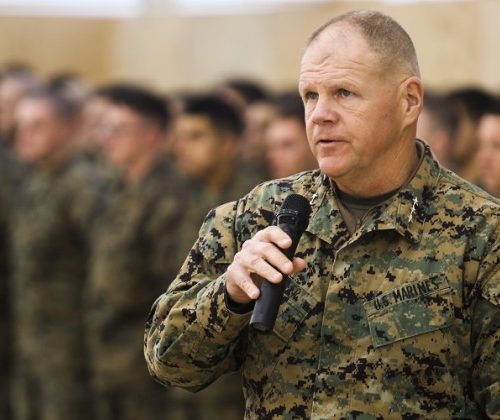
Commandant Gen. Robert Neller has put out the call for “disruptive thinkers” — Marines who live outside the box, love to challenge the status quo, and are often viewed as trouble makers.
“Good ideas are worthless unless acted upon, and the Corps could improve in this area,” Neller said.
It’s time they step up and speak out, Neller said, and it is time for leaders to listen. The commandant wants nothing short of a cultural revolution; a new era in which Marines are encouraged to come up with solutions, and leaders serve as advocates to accelerate those ideas to decision makers.
Neller addressed the issue at an innovation symposium hosted by the Marine Corps Warfighting Lab Feb. 23-24. The hundreds of Marines and industry officials in attendance were adamant: The system is broken. The Pentagon can’t fix itself, let alone these emerging issues. There are an increasing number of hot spots around the world; no two are alike, and the circumstances are ever changing and increasingly complex. Technologies that could help have often evolved before older technologies are even fielded.
That’s why leadership is looking to bypass the bureaucracy and harness the cognitive, creative, innovative abilities of rank-and-file Marines. This could be anything from a program designed to improve parts inventory or predict parts failures, to a tool fabricated at a local motor pool that cuts maintenance hours and errors. It may be an app that gives a ground pounder unprecedented situational awareness. It may involve the development of new technology, or adoption/adaptation of a commercial technology. It may follow the example of one of the Corps’ most famous trouble makers, Gen. Holland Smith, the World War II military leader considered by many to be the father of modern amphibious warfare. Even now, leaders are considering warfighting options ranging from beefed up company landing teams to a new deployment model that would disperse an amphibious readiness group the moment they get underway. They wouldn’t sail together, or wait until a mission arose to go into disaggregated ops.
Lt. Gen. Mike Dana, deputy commandant for installations and logistics, called for innovative ways to deal with anti-access/area-denial. While a high-end overmatch capability is needed, the three-star said simple things, such as a swarm of drones, are equally as important. He advocated the use of barges as sustainment lily pads, and the ability to convert commercial ships to military platforms, as Great Britain did during the Falklands war.
“If the Marine Corps didn’t exist, what would it look like if you had to form it?” Dana asked the participants. He made them write down and give him “the one thing would you change, do different, or make better.” And Dana wasn’t talking to a bunch of boot privates and butter-bar lieutenants. The symposium was invitation only. Attendees ranked from staff sergeant to master sergeant, and captain to lieutenant colonel. They were tested beforehand, and the vast majority were categorized as action-based, visionary pioneers — cutting-edge thinkers who represent about 2 percent of any given organization. Such Marines always have ideas, Neller said, but rarely have the opportunity to see those ideas progress to experimentation and application.
“Good ideas are worthless unless acted upon, and the Corps could improve in this area,” Neller said.
A recurring question he receives (second only to questions on the tattoo policy) is where Marines can submit ideas. He is working to fix that, and spoke of launching something similar to the Beneficial Suggestion Program, or BeneSuggs. “It will start raining goofy ideas, and goofy ideas are OK because they are well-intended and there is a pony in there somewhere,” he said. “We just have to find the ponies and let them run.”
But a high-speed suggestion box is not enough. Marines who promote new ideas and point out bad ideas often are not seen in a favorable light. They receive little encouragement, let alone the time and material needed to produce a solution.
Organizers brought in Avionics Technician 1st Class Richard Walsh to shed some light on the matter. Walsh is the 2011 Naval Aviation Enterprise Innovator of the Year and recently received honorable mention in the Secretary of the Navy Innovation Awards Program. Walsh’s Statistically driven Maintenance Analysis and Repair Technology, or SMART program, took years to develop. It improved repair time and saved the Navy tens of millions of dollars. Still, he finds himself in constant struggles, even arguments, with superiors who don’t want to make the change. “It’s dangerous, it’s scary, and it sucks,” he said.
The war colleges are strong indicators of how the culture of innovation has faded, in the eyes of noted military historian Williamson Murray, the Ambassador Anthony D. Marshall Chair of Strategic Studies at Marine Corps University. He described a time when innovation was embraced. Fleet exercises were followed by hot washes that included hundreds of officers who would watch admirals ruthlessly critique one another, and even invite the perspective of field grade officers. Murray pointed to people such as Adm. William Sims, who took a demotion to lead the Naval War College because it was the only agency looking at future of war; and Adm. Raymond Spruance, the “admiral’s admiral,” who went from unprecedented successes in the Pacific during World War II to serve as president of the Naval War College. Such commitment to innovation is not the attitude of today’s military.”The lack of participation by the Navy in its own war college is stunning,” Murray said.
The commandant wants something different from his Marines. Fittingly, he spoke with many of those leaders in The Gray Research Center, named for Commandant Gen. Al Gray, arguably one of the most innovative military leaders of modern times. “Most people with good ideas are annoying because they are frustrated,” Neller said. “The Marines that we want to re-enlist don’t want to stay because they get tired of being around stupid people. They do. They get frustrated, they get tired of beating their head against the wall. [They say] ‘You guys won’t listen to me, I’m outta here. I’m going to go to college and make a million bucks.’ And they do.”
Neller should know. He has a reputation for being a disruptive thinker. He admitted to being “such a pain in the ass” that his company commander planned to make then-2nd Lt. Neller the battalion’s food services officer. Neller went to his skipper’s hooch and “begged him to not do that.” He didn’t. Instead, the captain gave Neller some guidance and latitude. The bold young lieutenant still made waves, but he also made a difference. This pattern continued throughout the commandant’s career. Now, he wants leaders to identify the “wicked smart Marines” who can make a difference, challenge them, and “tolerate them to a point. If we ever stop doing that, I don’t think we should have a Marine Corps. I really don’t.”
To bring about a culture change, officials discussed everything from giving innovative Marines multiple MOSs based on aptitudes, to changing personnel reviews so they can better capture the contributions of Marines on hiatus from a primary MOS while they solve a problem. “Maybe we ought to get a little bit smaller, and raise the standards a little higher,” Dana said. The commandant went as far as ordering staff officers to challenge the status quo. “If you are not inquisitive as a staff officer, you are not doing your job,” he said. “You are derelict in your duties.”Allowing innovation is one thing. Applying innovation is another matter entirely.
This is not lost on the Defense Department, which on March 2 announced plans to establish a Defense Innovation Advisory Board to provide Pentagon leaders independent advice on innovative and adaptive means to address future organizational and cultural challenges. But the Corps is looking to eliminate some of the red tape and the “federated way of moving things forward,” as Dana puts it.
“The way you look at the problem can be the problem,” he said. For example, the Goldwater-Nichols Act is backward in that it puts majors, lieutenant colonels, and colonels on a staff and “just generates a bunch of work. It doesn’t move innovation forward, it just maintains the status quo,” he said. “The system doesn’t move fast enough. We need to use the [Special Operations Command] model. There is way too much middle management.”
Neller expressed the need to go “faster, cheaper, smarter,” instead of “hard, stupid and expensive … which is the choice too often in Pentagon.”
“Everything changes so fast and the rules are against us,” Neller said. “The most important thing we can do is be open to new ideas. Not to create chaos, not to create friction. But I am confident enough in the intellect and advice, that we will come up with the right solution, even if it is only 80 percent. If we do nothing, we lose. I am willing to take risk.”

